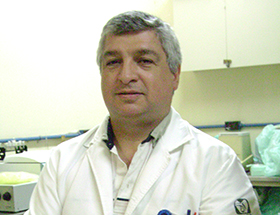
Sphingomyelinase enzymes are pathogenic factors of several intracellular bacteria species, which have been little studied in Mycobacterium tuberculosis. Cell free extracts from H37Rv and CDC-1551 M. tuberculosis strains were assayed for sphingomyelinase activity by using [N-methyl-14C]-sphingomyelin as substrate. Double-directional thin-layer chromatography was used to separate the substrate and hydrolysis product. Sphingomyelinase activity was analyzed as a function of incubation time, dose, pH and the presence of MgCl2, CaCl2, ZnSO4, HgCl2, MnCl2, CoCl2 and EDTA (1 or 10 mM). Mycobacterial preparations hydrolyzed [14C]-sphingomyelin, in time- and dose-dependent manners, producing [14C]-phosphorylcholine as a unique product. The activity of H37Rv neutral sphingomyelinase at pH 7.5 was 2.15 times higher than that of CDC-1551. This activity was inhibited 21-82% by Ca2+, Hg2+ or Zn2+ and EDTA, and stimulated 40-117% by Mn2+ and Mg2+. In addition, preparations from both strains showed two peaks of sphingomyelinase, one at pH 5.5 and the other at pH 3.0. However, these activities were 4-22 times lower than that observed at pH 7.5 for strain H37Rv. Preparations from H37Rv, but not those of CDC-1551, hydrolyzed sphingomyelin at pH 8-9, with a specific activity similar to that of the neutral CDC-1551 enzyme. Both strains H37Rv and CDC-1551 of M. tuberculosis have cation-dependent acidic and neutral sphingomyelinase-C enzymes, showing the neutral as the major activity. In addition, H37Rv has an alkaline sphingomyelinase-C. The importance of SMases in M. tuberculosis pathogenesis remains to be elucidated.









